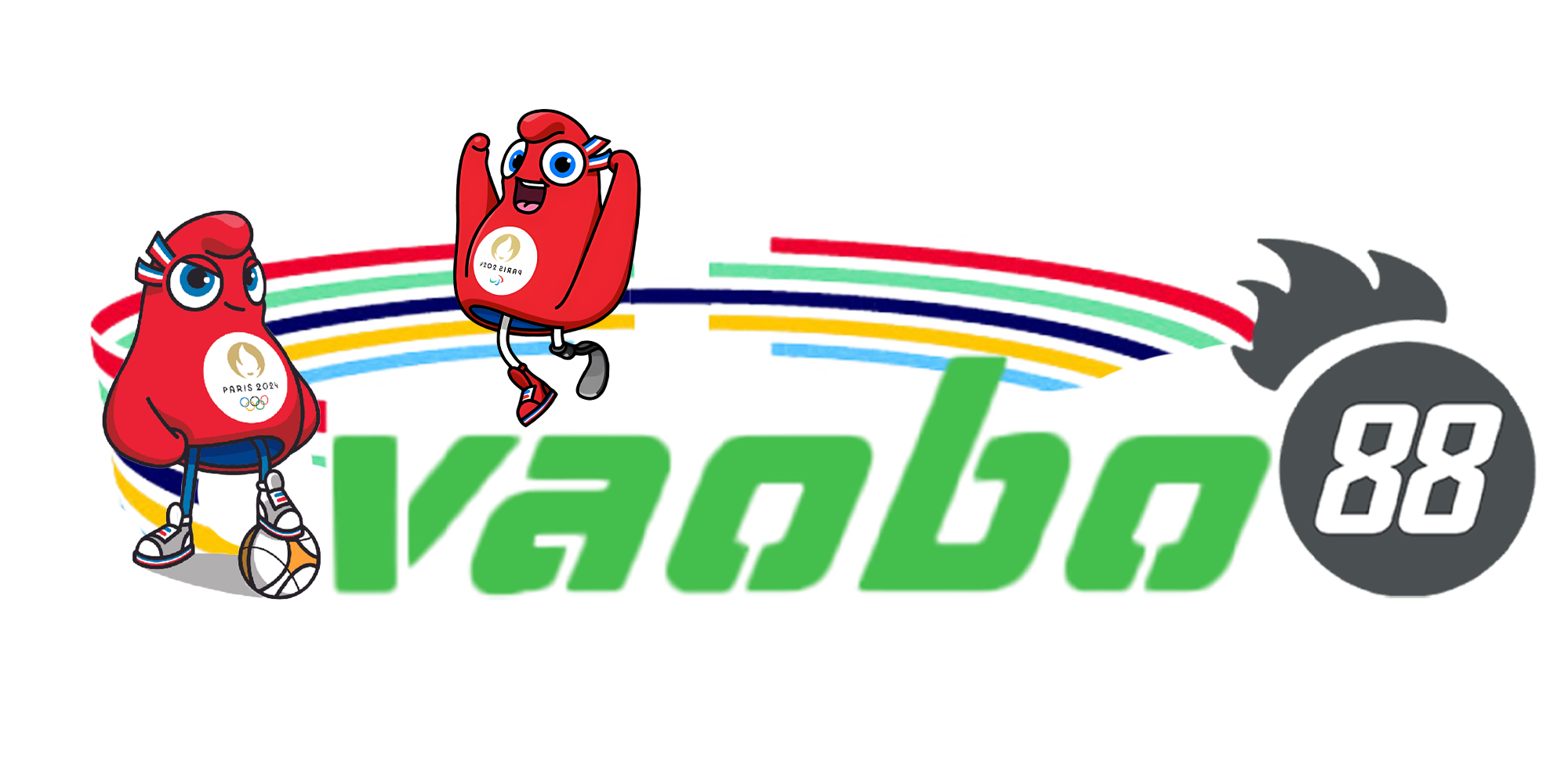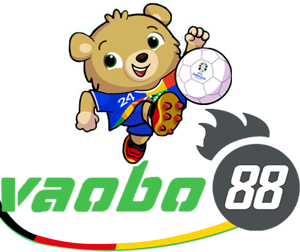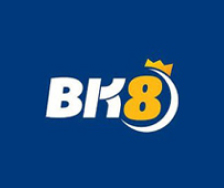Rubik game rules are being explored and understood by many young people to conquer the puzzling cube. This game is extremely popular across all countries from Europe to Asia. Learn to solve Rubik, win the game, and set many admirable records today.
Introduction to the Rubik game
Rubik (or Rubic) is one of the most loved intellectual puzzle games. The cube, full of puzzles but equally interesting, has caused billions of people to scratch their heads endlessly.
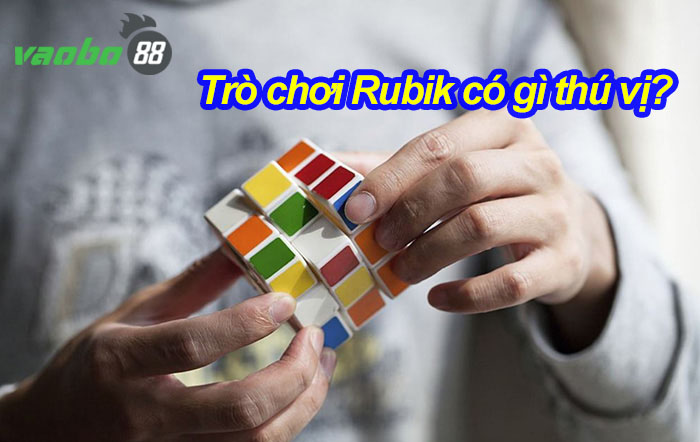
This game was invented by Erno Rubik – a Hungarian architecture professor. It was widely published to the public in 1974 and quickly became popular. It created a worldwide craze due to the super interesting Rubik rules. To this day, this game still maintains a huge attraction.
At first, players would just rotate intuitively and could not solve it successfully. Gradually, the Rubik rotation rules were discovered, and anyone could successfully rotate them. Rubik is considered to have the ability to develop intelligence and thinking for children. Therefore, parents often buy this toy for their children.
Initially, this puzzle game was designed in a 3x3x3 format consisting of 6 solid colored faces: red, orange, yellow, white, green, and blue. Nowadays, many other types of Rubik have been created, such as:
- 2x2x2 (Pocket Rubik)
- 4x4x4 (Revenge Rubik)
- 5x5x5 (Professor Rubik)
- 6x6x6 (V-cube 6)
- 7x7x7 (V-cube 7)
- Rubik Pyraminx (Triangle)
- Rubik Skewb Diamond
- Rubik Megamix
- Rubik Dogic
- Square -1
- Rubik Skewb Cube
- Rubik Mirror
- Rubik Snake
- Non-cubic Rubik
Before starting the game, you need to shuffle the positions of the cubes intuitively. If you apply the correct Rubik solving rules, you can solve any shuffled case.
Rubik game rules: Symbols on the cube
To begin the process of understanding the Rubik game rules, we first need to remember the important symbols. The faces of Rubik consist of many small faces, so it is very difficult to call them by their names directly.
a. Types of pieces in Rubik stacking rules
First, you must firmly grasp the definitions of the types of pieces in the Rubik game rules.
- Center piece: Has only 1 face, located at the main axis of the Rubik cube.
- Edge piece: Each face has 4 edge pieces for the 3x3x3 Rubik, this piece has 2 colors.
- Corner piece: Also in the 3x3x3 Rubik, the corner piece has up to 3 colors, and each large face has up to 4 such pieces.
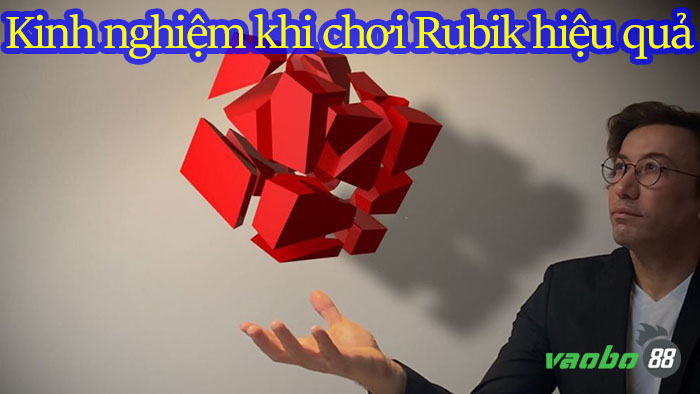
Rubik game rules
Of course, pieces with more than one color, such as edge and corner pieces, will belong to different faces.
b. Symbols of the faces according to Rubik game principles
Here, we will take the example of the basic 3x3x3 Rubik’s cube, using symbols for the faces to make the learning to play Rubik process simpler.
- The top face is denoted as U.
- The bottom face is denoted as D.
- The face opposite to the line of sight (the front face) is called F.
- The back face is designated as B.
- The left face is called L.
- The right face is named R.
These faces are completely independent of color; you can just take the Rubik’s cube and name them according to your line of sight. The nature of the faces is entirely the same, so when rotating, players only look at the colors to determine if they are playing correctly.
c. Rubik’s rotation rules by notation
After identifying the above notations, your Rubik’s rotation principles can be summarized according to them. Below are the variant notations based on the faces of the magical cube:
- Clockwise rotation: F, B, U, D, R, L.
- Counterclockwise rotation: F’, B’, U’, D’, R’, L’.
- Half turn (180 degrees): F2, B2, U2, D2, R2, L2.
When first getting acquainted with the rules of playing Rubik, you may encounter many difficulties in memorizing all the above notations. I advise players to stay calm and rotate slowly to gradually get used to the cube.
Rubik’s rules: How to solve Rubik
Currently, there are many information sites teaching how to play Rubik for everyone. However, not everyone understands the rules for decoding this cube.
I will detail each step, hoping that everyone can conquer the memorable milestone of successfully solving Rubik once.
In this article, I will take the white face as the top face; first, you just need to find the white center piece to place on top.
Step 1: Rotate layer 1 (top face – U)
Layer 1 is where the solution is the simplest and quickest. However, you also need to follow the Rubik’s rules to make it easier in the subsequent layers.
First, the player needs to create a white cross on the top face. This means you solve the center piece and 4 edge pieces in front.
- Step 1.1: Determine the position of the white edge piece that needs to be rotated up.
Move the edge piece to face F (the front face). At this point, the edge piece to be moved can be on layer 1, layer 2, or layer 3. Use F, F’ or F2, F2′ to bring it to layer 2 on the front right face (Position X as illustrated).
[caption id="attachment_29644" align="aligncenter" width="700"] Position X of the white piece that needs to be rotated
- Step 1.2: Determine the position to bring this piece to the top face. Rotate U or U’ to bring the edge piece to the top right position.
Position X with 2 cases as illustrated.
- Step 1.3: Execute the formula and bring that edge piece to position X.
- Case 1: Rotate R.
- Case 2: Rotate U F’.
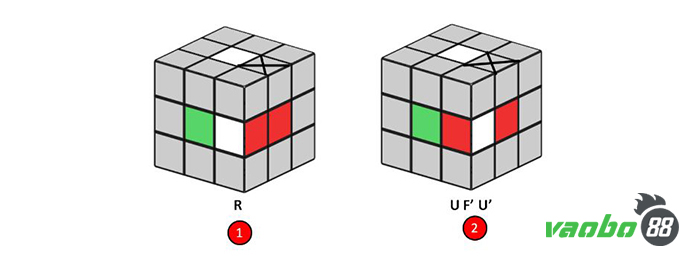
Rotate the edge piece of layer 1
Repeat the above steps for the remaining edge pieces. However, you need to be careful not to affect the pieces that have already been turned.
Step 2: Complete the 1st layer of Rubik
First, you should flip the Rubik cube over, with the yellow color on the top face and the white color on the bottom face.
According to the Rubik solving principle, players must observe and remember the positions of the white corner pieces.
If the white piece is on the 3rd layer, you should perform the U or U’ move to bring them to the cases shown in the image below.
(X is the position they need to reach after the following steps of the cube). Continue to rotate the cube according to the Rubik rules with the steps for the 3 situations in the image:
- Case 1: Use the formula U R U’ R’.
- Case 2: Use the formula R U R’.
- Case 3: Use the formula R U’ R’ U2 and then apply case 1 or 2.

Formula for rotating the edge piece of the 1st layer
If the white piece is on the 1st layer but in the wrong position or orientation, you need to bring it back to the 3rd layer using the formula R U R’ U’. Then use the methods for solving the 1st layer above to place them in the correct position.
After completing the Rubik rotation principle for the 1st layer, you will have a completely correct white face. Moreover, the edge pieces of the 2nd layer will also be in the correct positions corresponding to the center pieces.
Step 3: Solve the 2nd layer of Rubik
In the 2nd layer, your only task is to place the 4 corner pieces in the correct positions. First, you need to identify the positions of the edge pieces that do not have yellow color.
If the edge piece is on the 3rd layer:
- Step 3.1: Determine where the edge piece needs to go by observing its 2 colors. Mark the target position as Goal, holding the Rubik cube so that the Goal is on the F face (the face opposite your line of sight).
- Step 3.2: Rotate U or U’ or U2 to bring the edge piece closer to the Goal, so that the center axis of the F face matches the color and forms a seamless T shape.
- Step 3.3: Use the rotation steps according to the 2 cases shown in the illustration below.
- Case 1: Rotate U R U’ R’ F’ U F’.
- Case 2: Rotate U’ L’ U L U F U’ F’.
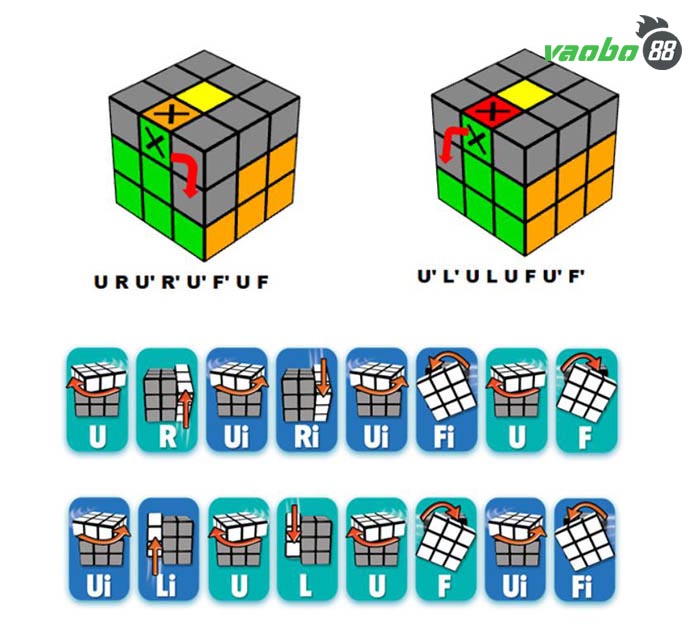
Formula for rotating the edge piece from the 2nd layer to the 3rd layer
If the edge piece is on the 2nd layer:
- Step 3.1: Use R U’ R’ or U’ F’ U F to rotate the edge piece to the position on the 3rd layer.
- Step 3.2: Apply the same steps as in the case above.
Step 4: Create a yellow cross on the 3rd layer
The 3rd layer in the process of solving the Rubik game rules always presents the greatest difficulty. The success or failure of all efforts is almost determined by this layer.
Many players master the rules above but falter at the threshold of success. Just one small mistake, and you will not be able to complete the Rubik cube at the final layer.
Here, I will suggest 2 methods aimed at completing this important step.
- Method 1: At this point, the Rubik’s cube will have 3 states on layer 3 including 1 Dot, 3 Dot in the shape of “L”, and 3 Dot in a straight line. However, you only need to rotate according to the formula F R U R’ U’ F’ for all three cases.
The number of rotations will decrease in the order I have listed:
-
- Case 1 Dot: Use the formula F R U R’ U’ F’ three times.
- Case 3 Dot in the shape of “L”: Use the formula F R U R’ U’ F’ two times.
- Case 3 Dot in a straight line: Use the formula F R U R’ U’ F’ once.
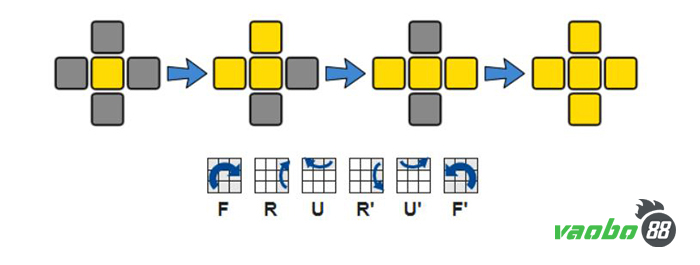
Formula for rotating edge pieces on layer 3
The image below is an example of the transformation of layer 3 with each rotation
- Method 2: This method only applies to the “L” Dot state above. Instead of rotating according to the formula 2 times, you only need to use F U R U’ R ‘F’ to finish.
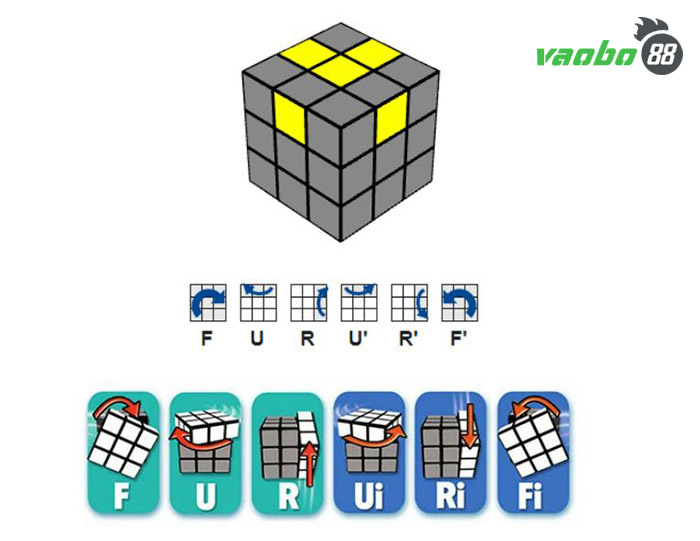
Quick rotation method when in “L” Dot state
Step 5: Position the cross pieces on layer 3 correctly
After completing step 4 in the Rubik’s game rules, the yellow edge pieces have formed a cross. However, the colors on the other side of them may not match the center pieces on the sides.
Before performing this step, you need to observe the edges that need to be swapped. Rotate the Rubik’s cube so that the two edges to be swapped are on the F face (front face) and the L face (left face).
Rotate according to the formula R U R’ U R U2 R’ U, the two edges that need to be swapped will exchange positions. According to Rubik’s game rules, you need to repeat this step until all the side faces have the correct color of the edge pieces.
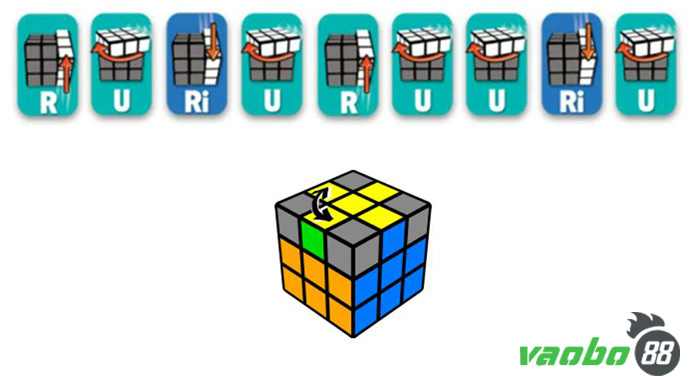
Step 6: Position the yellow corner pieces correctly
Similarly to solving the first layer in the Rubik’s game rules, after successfully positioning the edge pieces, it’s time for the corner pieces.
Continue to observe and determine whether the yellow corner pieces are in the correct position. As long as they are in the right place, that’s already lucky; if they are also the right color, that’s even better.
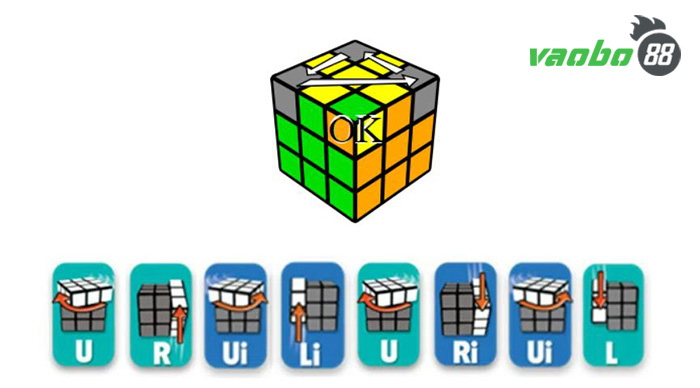
The correct position here is where the corner piece has 3 colors located at the intersection of those 3 colors. The number of correctly positioned corner pieces is always 0, 1, or 4.
- Case where only 1 corner piece is in the correct position: Rotate the Rubik’s cube so that this correct piece is at FRU (which means front, top, and right). Rotate according to the formula U R U’ L’ U R’ U’ L once.
- Case where no corner pieces are in the correct position: Rotate according to the formula U R U’ L’ U R’ U’ L two or more times until one corner piece is in the correct position, then perform the same steps as in the previous case.
- Case where all 4 corner pieces are in the correct position: Skip this step 6.
Step 7: Complete the Rubik’s Cube rules
After step 6, if all pieces are facing the correct direction, that’s great, you have decoded the Rubik’s Cube rules.
 Formula to rotate the yellow corner piece to the correct position
Formula to rotate the yellow corner piece to the correct positionHowever, life is not that easy, players often have to perform one last step as follows:
- Rotate the Rubik’s cube so that one incorrectly oriented corner piece is at the FRU position (front, top, and right) facing directly at you.
- Rotate according to the formula R’ D’ R D an even number of times (2, 4, 6, 8,… times). The yellow face will rotate clockwise after every 2 turns, when it is in the correct position, stop.
Note, the upper layers being scrambled is normal, they will return to their positions after completing step 7.
- Rotate U or U’ to bring the yellow squares that are still incorrectly oriented to the FRU position and continue using the formula above.
Experience in Rubik’s Cube rules
In general, Rubik is an intellectual game that requires extremely high skills from participants. Recorded records prove that humans can still decode this subject quickly.
Of course, you need to pay attention to a few experiences below if you want to succeed and gradually reduce the time to conquer the interesting cube mentioned above:
- Every time you rotate, the layers that have been completed before will be continuously scrambled. However, you don’t need to worry about that, if you follow the formula correctly, everything will return to normal after completion.
- The middle face never changes position no matter how you rotate it. Players need to manipulate so that the other faces are the same color as this one.
- The number of edge pieces is 12 (2 colors) and corner pieces is 8 (3 colors).
- You need to follow the Rubik’s Cube rules correctly to grasp the symbols as well as the basic gameplay.
Conclusion
Rubik’s Cube rules require players to understand the rules and have high perseverance. New players often fall into a state of frustration and give up when continuously making mistakes with the formulas.
Those who persist until the end will achieve admirable results. This game brings many benefits, so you shouldn’t miss it.
